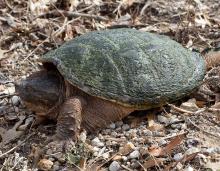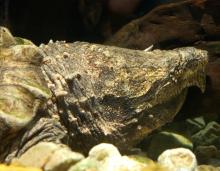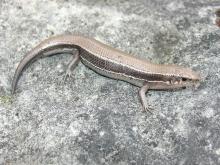Reptiles and Amphibians
Media

Species Types
Scientific Name
Chelydra serpentina
Description
A large aquatic turtle with a big pointed head, long thick tail, and small lower shell, the eastern snapping turtle is common throughout the state, anywhere there is permanent water.
Media

Species Types
Scientific Name
Macrochelys temminckii
Description
In Missouri, alligator snapping turtles are protected, and it is illegal to harvest them. This species is totally aquatic and rarely leaves the water. In Missouri, it mainly occurs in the large rivers, sloughs, and oxbow lakes of our southern, southeastern, and eastern counties.
Media

Species Types
Scientific Name
Storeria dekayi
Description
Dekay's brownsnake is a small, secretive species that prefers moist environments. It can be gray to brown to reddish brown. It usually has a tan stripe running down the back, bordered by two rows of small brown spots. The top of the head is usually dark. Occurs statewide.
Media

Species Types
Scientific Name
Plestiodon anthracinus pluvialis
Description
The southern coal skink is secretive. It lives in the southern half of Missouri, excluding the Bootheel. Adults are small, shiny, and brownish, with a wide, coal-black line on the side. Juveniles are black with faint lines down the back and sides and a blue-gray tail.
See Also
About Reptiles and Amphibians in Missouri
Missouri’s herptiles comprise 43 amphibians and 75 reptiles. Amphibians, including salamanders, toads, and frogs, are vertebrate animals that spend at least part of their life cycle in water. They usually have moist skin, lack scales or claws, and are ectothermal (cold-blooded), so they do not produce their own body heat the way birds and mammals do. Reptiles, including turtles, lizards, and snakes, are also vertebrates, and most are ectothermal, but unlike amphibians, reptiles have dry skin with scales, the ones with legs have claws, and they do not have to live part of their lives in water.





















